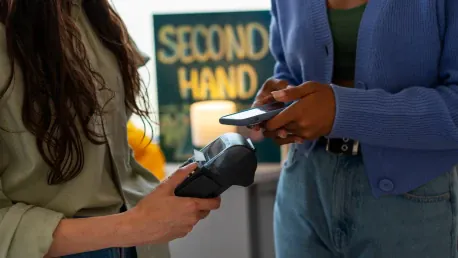Listen to the Article
Imagine this scenario: you’re working from a busy coffee shop, and the wi-fi is a little spotty. To remain connected to the internet, you’re likely to turn on your personal hotspot on your mobile device and share connectivity with your laptop. When you’re done for the day, you’ll likely reach back for your phone to settle the bill using a digital wallet like Apple or Google pay.
Mobile devices demonstrate how banks and telecommunications companies converge to provide services to end-users.
As businesses strive to remain competitive, they aim to be a single provider for customer needs. This trend has led to the convergence of banking and telecommunications; as the world becomes more digital, banks are seeing the opportunity to provide connectivity and offer these services within a single app.
Here’s how these two—formally distinct industries—have started to collide:
An Overview of the Landscape
Consumer banking has undergone several iterations over the last decade alone. Almost as soon as “tap-to-pay” became popularized on debit and credit cards, Near Field Communication (NFC) technology made Apple and Google Pay possible. Physical cards are almost never required and were replaced by virtual cards, instant EFT, and a number of third-party payment apps like Cashapp and Zelle.
Banking itself is a digital activity, and the reasons for visiting a brick-and-mortar branch are fast dwindling. As trends tend toward Banking 4.0, a future state of retail banking that is connected, intuitive, secure, and responsive to consumer needs, banks are likely to add services that prioritize convenience.
The retail financial services industry is poised for change as convergence becomes more common. Going back to the example of the person in the coffee shop, mobile devices are at the epicenter of this evolution. As smartphones were used for everything from booking flights to watching Netflix, connectivity became a central issue to solve. This was the genesis of the Mobile Virtual Operator Network (MVNO).
Banks have entered the MVNO industry and this will have a profound effect on the relationship between banking and telecommunications. Let’s explore the factors that have propelled banks to merge with telecommunications.
Connectivity as a Commodity
Since 2016, access to internet has been considered a human right. This is not to suggest that banks have altruistic intentions in entering the industry, but rather underscores the need for more providers with innovative solutions.
For telecommunications companies, banks are an unwelcome presence, driving competition and lowering costs. Customers, looking for a single service provider for all their needs, are compelled to switch to service providers that can offer competitive rates and a plethora of services. Chief among their concerns is the capital-intensive nature of managing a telecommunication company. As fast and cheap connectivity becomes the crown jewel in terms of service offering, messaging, data, and voice call packages are less lucrative but increasingly cost more to offer. It’s a matter of adapt or die as internet service providers (ISPs) emerge offering cheap, fast, and unlimited data.
It was predicted as early as 2005 that voice and subscriber rates would decline. Legacy telco providers around the world are experiencing the same phenomenon, as digital adoption increases globally and voice revenues steadily decline.
But these businesses have a trick card up their sleeve: large customer databases. While newer ISPs struggle to break through the noise, telecommunication companies already have massive banks of data at their fingertips. Understanding and meeting consumer needs may be their final hail mary.
Telecommunications and Banking
From the perspective of telecom providers, integrating financial content represents a lucrative opportunity. A combined banking and mobile communications offering enables telecom companies to move beyond basic voice services, helping them stand out in a highly competitive market and reduce customer churn.
Additionally, financial information is naturally suited for delivery via wireless networks, as it already exists in a format compatible with telecom systems. Decades ago, Citicorp’s chairman Walter Wriston noted that the electronic transmission of financial data was indistinguishable from other forms of digital communication, such as news broadcasts. Today, the same principles allow seamless transactions—like a business traveler using their mobile phone to pay for a meal in one country while the payment clears through a bank in another.
Telecom companies’ customer relationships share similarities with banking. For instance, billing for long-distance calls parallels credit management. Furthermore, telecoms have expertise in handling micro-transactions, an emerging trend in payment services.
Both industries share histories of state ownership, operate under strict regulations, and continue to undergo consolidation. Notably, they were pioneers in leveraging the Internet to develop innovative business models.
Meeting Consumer Needs
The banking and telecommunications industries may share a number of similarities, but alliances are not easily forged. Consumer habits are still the prevailing force that dictates the shape of the industry. While it may seem like touting the economic benefits of a merger is in the customer’s best interest, this isn’t nearly enough.
Consumers are conservative with their banking, but progressive with their expectations of ISPs and mobile service providers. Despite the widespread proliferation of internet banks, traditional banking customers continue to vote with their feet—and their wallets—for banks that still have a brick-and-mortar presence. There’s a psychological safety attached to the physical presence of an institution as sensitive as a bank.
This idea perfectly demonstrates how economic benefits don’t always translate into consumer preference. Customers still want to know that their bank exists, even if they use an app, and need to know human help exists, even if they use customer service self-help guides.
But, as mentioned, the same isn’t true of how consumers transact. They’re comfortable using third-party payment apps, with approximately 76% of Americans having used a platform like Paypal, Venmo, CashApp, or Zelle. Another sign of transactional innovation that’s readily accepted is the use of mobile devices for payments.
The most successful innovations in the industry add value to people’s lives in simple and meaningful ways. The mobile phone, with internet connectivity and financial services, is an example of meaningful and valuable change.
Concluding Thoughts
In a rapidly evolving digital landscape, the convergence of banking and telecommunications represents a transformative shift in how consumers interact with financial services. By integrating connectivity with financial tools, banks and telecoms can enhance convenience, accessibility, and efficiency for end-users.
For telecom providers, this partnership offers a pathway to move beyond traditional voice and data services, leveraging their extensive customer bases and infrastructure to innovate. For banks, this evolution aligns with the demands of Banking 4.0—offering seamless, secure, and intuitive solutions.
However, these alliances must address consumer hesitancies and infrastructure challenges to succeed. By focusing on enhancing user experiences and building trust, this collaboration has the potential to redefine industries and meet the growing demand for integrated, on-the-go services. Together, banks and telecoms stand poised to deliver value in a way that complements, rather than complicates, consumers’ lives—a true match made in cyber heaven.









